|
||||


Articles |
|
| • | Excalibur Extreme Fight Challenge XIII Results New |
| • | The Art of Eight Limbs New |
| • | A New Me New |
| • | Our Society New |
| • | K-1 Grand Prix Semi-Final Results |
| • | What Does it Mean to be a Black Belt? |
| • | Women Kick Boxing in Thailand |
| • | Training in the Martial Arts |
| • | Black Belt |
| • | Running and Jogging Safety |
| • | My Injury |
| • | Common Sense Self-Defense |
| • | Submit Your Article to Tuffgrrlz |
Martial Arts |
|
| • | Links |
| • | Martial Arts Classifieds |
| • | Schools |
| • | WCT Tournament Pics |
| • | SKF Tournament Pics |
| • | Tips & Techniques |
| • | Upcoming Events New |
Miscellaneous |
|
| • | Female Fighters Seeking Competition New |
| • | Tuffgrrl Gallery New |
| • | Quotes from Class |
| • | Enter the tuffgrrlz Community! |
Tuffgrrlz Store |
|
| • | Muay Thai Tuffstuff! New |
| • | Let Everyone Know You're Born to Fight! New |
| • | Kick Butt Tuffstuff New |
| • | Stuff that's Fit to Fight New |
Submitted by Kitipan
Article Courtesy of Thai Collectible


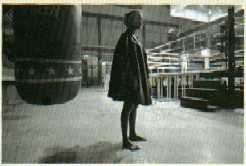
from Sawasdee Magazine, Volume 29, Number 10 ' October2000;
At first glance, the large, sparsely furnished dormitory could be the living quarters of any trio of typical Thai teenagers. On top of a low cabinet in one corner, cutesy cupid figurines vie for space with a large bridal doll dressed in ruffled white organdy and bottles of beauty
Care products. Hello kitty paraphernalia cram the shelves of the single
wardrobe. On the wall, next to the scotch-taped poster of a local rock
band, sits a small Buddhist shrine. The room's 17-year-old inhabitants
themselves also represent a standard cross section of Thai teenagedom.
Jaeda from CHIANG MAI is currently relaxing in bed with a mudpack on her
face. A ghetto blaster blares out pop tunes. Two portable fans at the
foot of the narrow metal cot circulate warm air in her general direction.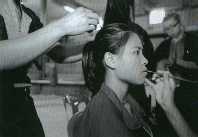
Her roommates Fah Sathan from Khon Kaen and Soi Dao from Chantaburi are not around, but several stuffed animals and a half-finished jigsaw puzzle on the floor attest to their recent presence.
On closer inspection of the room, however, certain anomalies belie the ordinariness of its residents. Among the tiny statuettes arrayed around the bridal doll is a framed photo of a young woman dressed in red satin boxing gear.
Facing the camera, she assumes the classic MUAY THAI (Thai kick boxing) stance: knees slightly bent ,gloved hands raised.
And instead of the dresses and blouses normally found in teenagers' cupboards, this one is filled with sports apparel sleeveless jerseys, shiny satin boxing trunks and mini capes. The Buddhist reliquary too is unusual. In addition to the standard offerings of incense sticks, vases of fresh flowers and dried jasmine garlands, three mongkon (ceremonial headbands worn by Muay thai boxers at the start of a match) hang from the corners.
Actually, the young women are Nak Muay Ying (female boxes). In boxing parlance Fah Sathan fights in the junior flyweight category, Soi Dao is a flyweight, and Jaeda a pin-weight. Along with three other teenagers(including Rung-arun Sor Fongnom, the country's hottest female fighter) ,they live upstairs at the Muay Thai Institute (MTI), an unimposing five-story structure located behind a disco on the outskirts of Bangkok. Ranging in age from 15 to 17, the girls train six days a week from 5.30am until 7pm-with time out for meals and naps-and attend high school on Sundays.
The ground floor of the building houses the 2,000-seat Rangsit stadium which boasts the country's first officially sanctioned boxing ring for women. Fah Sathan and her cohorts are in the vanguard of a quiet revolution that is upending the rarified male-only world of kick boxing in Thailand.
Long-held superstitions and prejudices that women pugilists will jinx any ring they fight in have traditionally colored local attitudes toward nak muay ying.
Thai women have not fought professionally since the late '60s when Amnuay Kesbumrung, current president of the MTI and a former fighter himself, tried to popularize the sport by holding female bout at the famed Lumpini Stadium. However, he abandoned the idea after three years because the predominantly male Thai fans refused to watch -- or more crucially bet on -- the matches. In the ensuring four decades, the only place to see women boxing was a provincial temple fairs and festivals.
So what was it that created the second coming of kick boxing for Thai women? Essentially the impetus came from abroad. Over the last decade, women throughout Europe, Australia, the US and Japan have been taking up Muay Thai as a form of exercise and self defense. Wanting to test out their skills in the country where the sport originated, the foreign boxes came here only to discover a dearth of qualified local opponents.
"Thai women weren't being properly trained and the foreigners basically destroyed them," recounts Niamh (pronounced Neve) Griffin, a junior featherweight champion from Ireland. "It was humiliating for the Thais." Under pressure to even up the boxing scores, in 1998 Amnuay resuscitated the idea of promoting women's fights. This time, however, he decided to provide women -- and any interested men -- with an on-site school as well as just a sport venue.
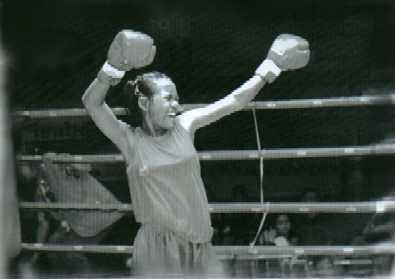
Thai Women are in the vanguard of quiet revolution that is upending the rarified male-only world of kick boxing in Thailand
In conjunction with the World Muay Thai Council, he turned Rangsit stadium -- the smallest of city's three boxing arenas -- into a certified training facility. Because the male fighters categorically refused to let women inside the existing ring, Amnuay had to build a second one.
Despite the "separate but equal" facilities, male boxers still climb into Rangsit's woman-only ring for their practice sessions, even though the ban on women using theirs remains in full sexist force. Nonetheless, Rangsit is a welcome alternative to most of the country's provincial boxing camps and gyms which will not even let women into the premises, much less allow them to train. And the few that do offer training, hold them to their gender biases when it comes to entering a ring.
Once inside the ring, Thai women fight
just as intensely as their male countrymen. The only difference between
the five-round matches is that men fight three-minutes rounds with one-minuted
breaks, while women go for two-minutes with two-minutes breaks.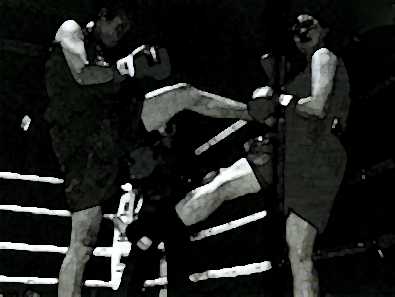
In sharp contrast to the Thai stereotype of smiling gentleness, the sport combines graceful physicality with grunting savagery that can break bones and draw blood. Even the name of the various move conjure up an aura of violence: Mountain Overturns Earth, Break the Elephant's Neck, Rama Pulls the Arrow String.
As in men's Muay Thai, each match begin with the ceremonial Ram Muay dance taken from the Ramakien ( a Thai epic closely based on the Hindu Ramayana). Wearing the traditional Mongkon haedbands created from written monk's prayers that are wrapped in silk thread, the boxer move gracefully in the center of the ring, bowing in all directions. The dance is a mark of respect for the boxer's trainer and parents. As Niamh explains, "It also serves to calm a fighter so she can take possession of the ring and feel safe there." Supposedly in the past you could tell which gym a fighter came from on the basis of the style of the dance. Nowadays this is no longer true.
Once the fight starts, the boxers are in constant motion, except when they get backed into a corner or clinch together with their red-gloved hands around each other's necks. A good fighter never throw just one kick and stops; she immediately follows through by thrusting a knee, elbow or fist at any part of her opponent's anatomy. Like the men, the women fight barefoot and ware no protective gear apart from a padded bra and crotch guard. (Amateurs cover the head, elbows, knees and waist with padded guards.)
Rangsit's bi-weekly Saturday night matches
attract female fighters from all over Thailand, Australasia and Europe.
Nowhere near as profitable as the raucous, jam-packed matches held at
Ratchadamnoen and Lumpini Stadiums, the events rarely pull in large crowds.
Only when local champion Rung-arun, or one of the famous foreigners like
Niamh Griffin, appear on the program does attendance rise above 100 spectators.
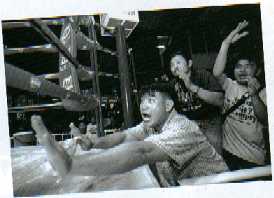 The low turnout doesn't seem to deter the contenders who, whatever
their level of expertise, treat their opponents like humen punching bags.
A well-fought match generates incredible intensity in and out of the ring.
The increasingly frenetic rhythms of the traditional three-piece band
and the loud shouts of "Oy, oy, oy" from the crowd ramp up the intensity
still higher.
The low turnout doesn't seem to deter the contenders who, whatever
their level of expertise, treat their opponents like humen punching bags.
A well-fought match generates incredible intensity in and out of the ring.
The increasingly frenetic rhythms of the traditional three-piece band
and the loud shouts of "Oy, oy, oy" from the crowd ramp up the intensity
still higher.
The 63-year-old Amnuay works tirelessly to promote his "girls" at home and abroad. He has already taken Rung-arun, Fah Sathan and Soi Dao to Singapore for exhibition matches and dreams of organizing a fight between Rung-arun and Lila Ali (Mohammed's daughter) in two or three years.
Like many other Thai promoters and trainers, he's extremely paternalistic -- and strict -- with his teenaged charges. Those who flaunt his 9pm curfew can look forward to a close encounter with the bamboo stick.
The age factor creates some interesting
dilemmas. The current crop of Thai women contenders are mostly teenagers
who come from low-income, rural backgrounds. Boxing gives them full-time
career with unprecedented travel and money-making opportunities. Even
so, most plan to quit the profession by their early 20s to get married.
On the other hand, the realities of life outside Thailand mean few foreign
women can afford to devote themselves full-time to a career that requires
three- to four-week restorative breaks between bouts. Their training get
sandwiched in between regular jobs and they're often considerably older
--sometimes by 10 years or more -- than their Thai opponents. In a society
like Thailand, where ages correlates with experience, the older foreigners
are assumed to be stronger fighters. 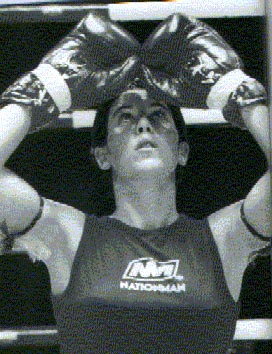 To even out the perception of the odds, women like the 20-something
Niamh (who bagan her meteoric career in Bangkok in 1998) sometimes subtract
a few years from their age.
To even out the perception of the odds, women like the 20-something
Niamh (who bagan her meteoric career in Bangkok in 1998) sometimes subtract
a few years from their age.
The fledgling career of one Thai Boxer may help change local attitudes towards age. Since childhood, 28-year-old Boontern Kijtmuti always wanted to be a boxing champion. After completing her basic schooling, she helped her mother selling noodle soup from a streetside cart in Bangkok before starting her own noodle vending business. By 17 she was married and soon had two sons (now 10 and 8) to care for. After her marriage fell apart, Boonterm decided it was time to pursue her dream. Leaving her sons with their grandparents, she took a part-time job in restaurant and began training. (To help defray costs, she also washes the gym's laundry twice daily). In late June, after only three months of training, Boonterm won her first match at Rangsit Stadium.
Meanwhile, both Amnuay and his Western-educated
son Nutchakorn Kesbumrung (who holds the imposing title of deputy director
of foreign affairs at MTI) devote most of their energy --and money --
to changing the Thai perception of women boxers. 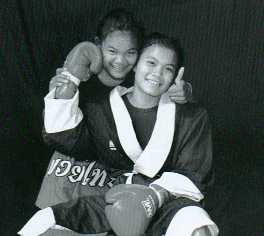 Lacking and sponsorship, they defray the costs of the Saturday night
bouts with funds from other family-run businesses (a disco and car dealership).
At the close of typical Saturday night, Amnuay sits at the ticket booth
near the entrance to the stadium and doles out money to the fighters.
Win or lose, each yong women gets paid (usually US$25-$75). Not much compared
to the fees for the highly lucrative men's matches, but enough to sustain
a sense of pride and accomplishment.
Lacking and sponsorship, they defray the costs of the Saturday night
bouts with funds from other family-run businesses (a disco and car dealership).
At the close of typical Saturday night, Amnuay sits at the ticket booth
near the entrance to the stadium and doles out money to the fighters.
Win or lose, each yong women gets paid (usually US$25-$75). Not much compared
to the fees for the highly lucrative men's matches, but enough to sustain
a sense of pride and accomplishment.
"If we stop trying, there'd be nothing," says Nutchakorn "We're planting the seed. And we'll keep up the women's fights for as long as we can because we truly believe that one day it will become a popular sports."
